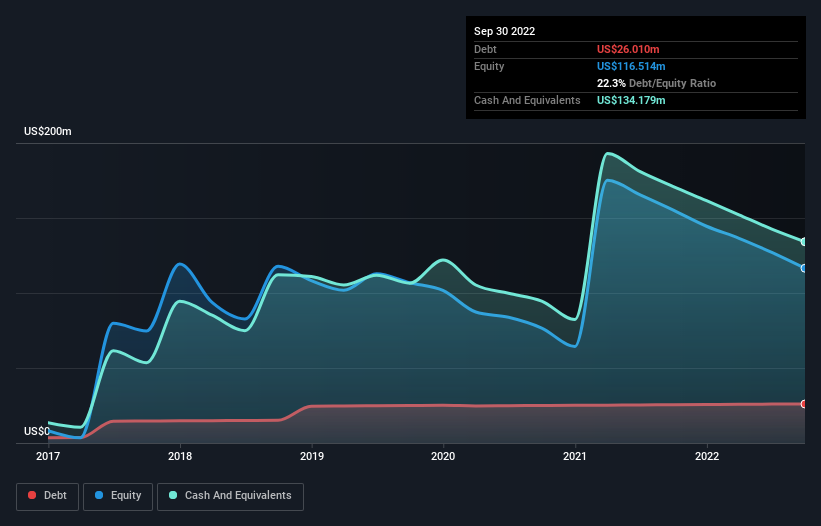
Warren Buffett famously said, 'Volatility is far from synonymous with risk.' When we think about how risky a company is, we always like to look at its use of debt, since debt overload can lead to ruin. As with many other companies Savara Inc. (NASDAQ:SVRA) makes use of debt. But the more important question is: how much risk is that debt creating?
When Is Debt Dangerous?
Debt and other liabilities become risky for a business when it cannot easily fulfill those obligations, either with free cash flow or by raising capital at an attractive price. Ultimately, if the company can't fulfill its legal obligations to repay debt, shareholders could walk away with nothing. However, a more common (but still painful) scenario is that it has to raise new equity capital at a low price, thus permanently diluting shareholders. By replacing dilution, though, debt can be an extremely good tool for businesses that need capital to invest in growth at high rates of return. When we think about a company's use of debt, we first look at cash and debt together.
Check out our latest analysis for Savara
What Is Savara's Debt?
As you can see below, Savara had US$26.0m of debt, at September 2022, which is about the same as the year before. You can click the chart for greater detail. However, its balance sheet shows it holds US$134.2m in cash, so it actually has US$108.2m net cash.

How Strong Is Savara's Balance Sheet?
According to the last reported balance sheet, Savara had liabilities of US$5.16m due within 12 months, and liabilities of US$26.1m due beyond 12 months. Offsetting these obligations, it had cash of US$134.2m as well as receivables valued at US$861.0k due within 12 months. So it can boast US$103.8m more liquid assets than total liabilities.
This excess liquidity is a great indication that Savara's balance sheet is almost as strong as Fort Knox. With this in mind one could posit that its balance sheet means the company is able to handle some adversity. Succinctly put, Savara boasts net cash, so it's fair to say it does not have a heavy debt load! When analysing debt levels, the balance sheet is the obvious place to start. But it is future earnings, more than anything, that will determine Savara's ability to maintain a healthy balance sheet going forward. So if you want to see what the professionals think, you might find this free report on analyst profit forecasts to be interesting.
Given its lack of meaningful operating revenue, Savara shareholders no doubt hope it can fund itself until it has a profitable product.
So How Risky Is Savara?
By their very nature companies that are losing money are more risky than those with a long history of profitability. And in the last year Savara had an earnings before interest and tax (EBIT) loss, truth be told. Indeed, in that time it burnt through US$35m of cash and made a loss of US$39m. But at least it has US$108.2m on the balance sheet to spend on growth, near-term. Even though its balance sheet seems sufficiently liquid, debt always makes us a little nervous if a company doesn't produce free cash flow regularly. When analysing debt levels, the balance sheet is the obvious place to start. However, not all investment risk resides within the balance sheet - far from it. For example, we've discovered 2 warning signs for Savara (1 is a bit unpleasant!) that you should be aware of before investing here.
If you're interested in investing in businesses that can grow profits without the burden of debt, then check out this free list of growing businesses that have net cash on the balance sheet.
New: Manage All Your Stock Portfolios in One Place
We've created the ultimate portfolio companion for stock investors, and it's free.
• Connect an unlimited number of Portfolios and see your total in one currency
• Be alerted to new Warning Signs or Risks via email or mobile
• Track the Fair Value of your stocks
Have feedback on this article? Concerned about the content? Get in touch with us directly. Alternatively, email editorial-team (at) simplywallst.com.
This article by Simply Wall St is general in nature. We provide commentary based on historical data and analyst forecasts only using an unbiased methodology and our articles are not intended to be financial advice. It does not constitute a recommendation to buy or sell any stock, and does not take account of your objectives, or your financial situation. We aim to bring you long-term focused analysis driven by fundamental data. Note that our analysis may not factor in the latest price-sensitive company announcements or qualitative material. Simply Wall St has no position in any stocks mentioned.
About NasdaqGS:SVRA
Savara
A clinical stage biopharmaceutical company, focuses on rare respiratory diseases.
Flawless balance sheet with high growth potential.
Market Insights
Community Narratives




